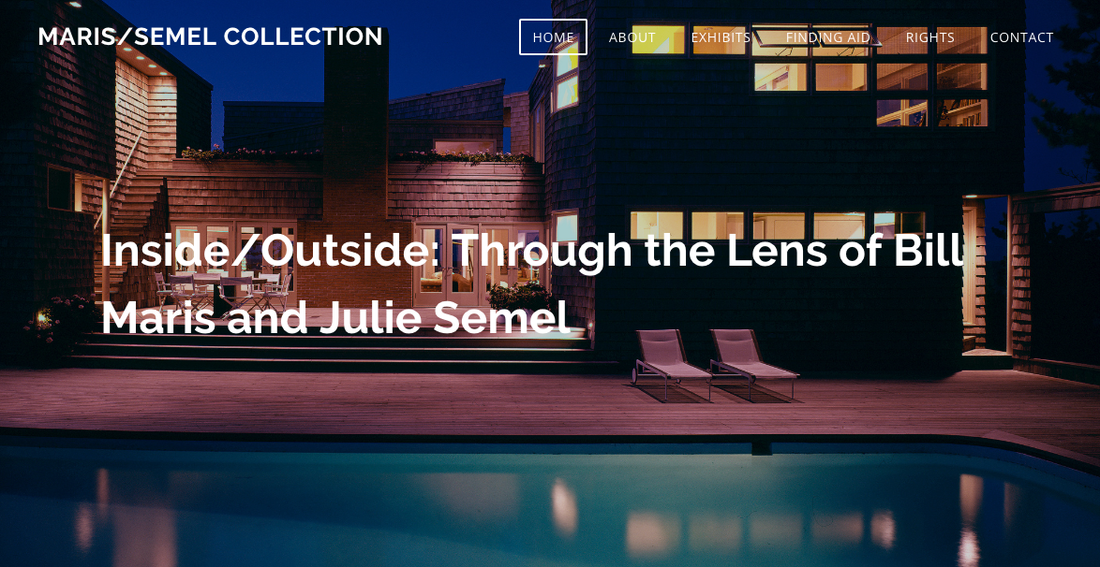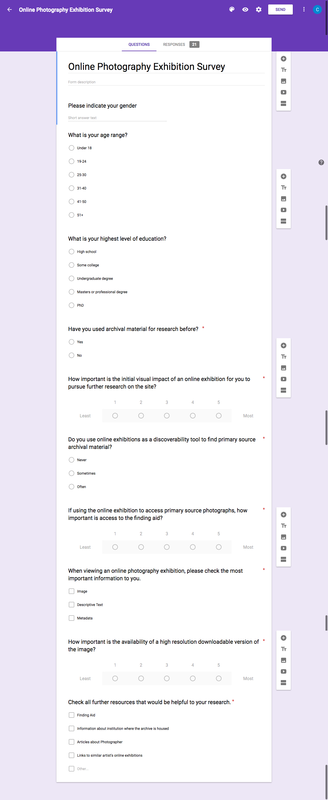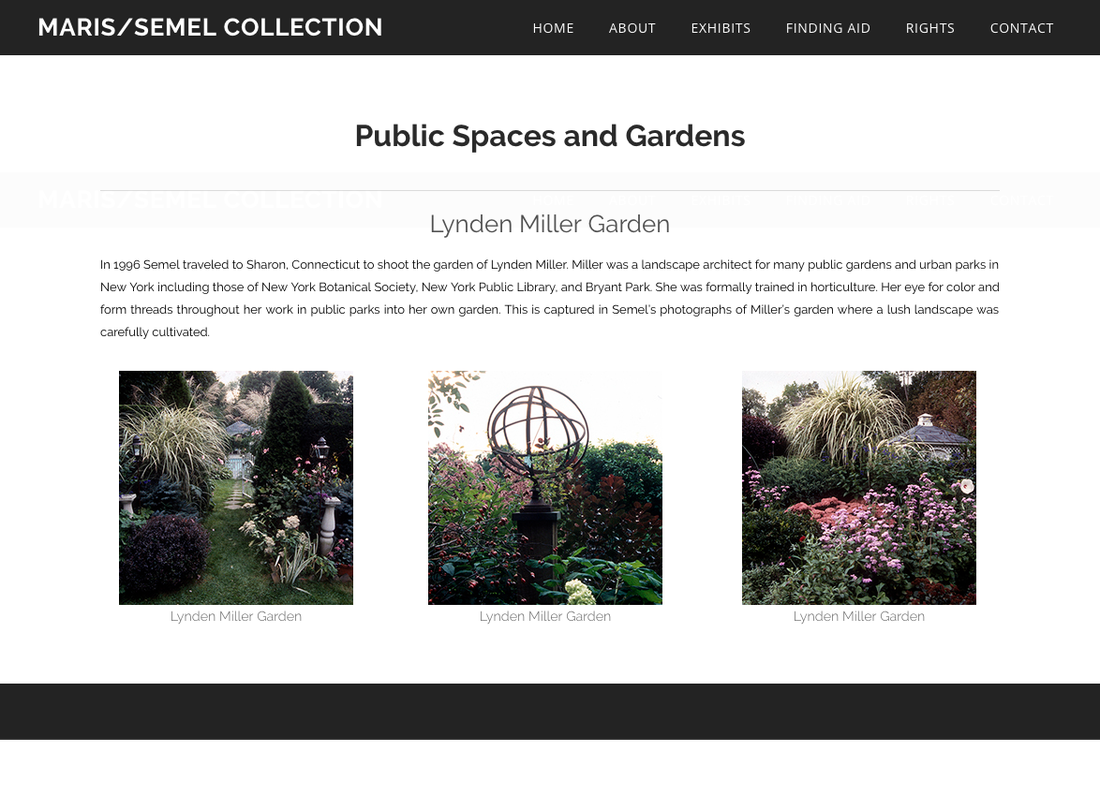INSIDE/OUTSIDE: THROUGH THE LENS BILL MARIS & JULIE SEMEL: A CASE STUDY
The Project in Digital Archives course taught at Pratt Institute's School of Information focused on a digitization and curation project of the Bill Maris and Julie Semel photography archive. As a class, we were responsible for the processing of material, digitization of the 35mm slides as well as the curation and creation of an online exhibition. As part of the online exhibition group, we worked closely with curatorial, who identified four themes in Bill Maris’ photography that they would like to celebrate in separate “galleries” of an online exhibition.
Research
At the beginning of the semester we met with the curatorial group, who identified four themes in Bill Maris’ photography that they would like to celebrate in separate “galleries” of an online exhibition. Once we familiarized ourselves with the content to be displayed in the digital archive, we began outlining our research methods. Broken into two sections: the first, called “Understanding Content,” contains a competitive analysis that drills into design elements applied by other online exhibitions of a similar scope. The second section, called “Understanding Users,” applies research methods to collect data that sheds light on our prospective site users. We then communicate our user data by developing personas and scenarios that answer the questions: Who are our users? What are their information needs? What are their pain points?
Understanding Content: Competitive Analysis
We began by first evaluating user needs from an aesthetic perspective. As this is a photography collection, we wanted the emphasis to be on the image, yet still support comprehensive curatorial information and metadata. As a group, we searched for online exhibitions of photography collections and archives and chose three external sites with elements applicable for the online exhibition. Once selected, a competitive analysis was conducted comparing and contrasting three external websites that we felt exemplified these elements, The Newberry Library, Museum of Contemporary Photography, and Making Pictures of People. Our analysis considered the dimensions of content, navigation and appearance of each external site by assessing what works, what does not work, and a summary of our key findings, which can be found below.
APPEARANCE
- Image must be highlighted and impactful in order for user to be motivated to explore the online exhibition.
- Modern, minimal layout themes compliment and support contemporary photographic images.
NAVIGATION
- Images displayed in multiple formats and places are most impactful for the user.
- Cohesive and consistent format for each section increases discoverability.
- Breadcrumbs are necessary for the user to know where they have been and where they want to go to find meaningful information.
CONTENT
- Online exhibitions that focus on photographs should be visually impactful.
- Descriptive text and structured metadata is crucial to the online exhibition’s credibility.
- A finding aid would promote access to primary source material featured in the online exhibition.
Understanding Users: Research Methods
The user groups for the Maris/Semel Archive have been identified as architectural students, visual artists, photographers, journalists, set designers, graphic designers, historians, archivists and librarians. A survey was created and administered to 20 respondents who fit the criteria of the user group. The questions ranged from basic demographic information to specifics regarding archival research, visual impact and breadth and depth of content within an online photography exhibition. These questions focused on what information resources users would find most meaningful for online photography exhibitions.
Based on the results of both the competitive analysis and survey we came to the following conclusions:
- The majority of users are familiar with working with archival material at an academic level.
- Users view online exhibitions as discoverability tools for primary source archival material and regard access to the finding aid an important tool.
- Visual impact of an online exhibition is crucial to whether the user will utilize it as a credible resource for their research.
- The image is the most meaningful source of information, and a downloadable version would be beneficial to the user.
- Besides the finding aid, users would find additional resources such as information about the institution, articles about the photographer and links to similar online exhibitions useful.
Based on this research, I summarized these findings in a formal user brief, which supported the competitive analysis findings, and allowed the group to develop wireframes of the intended site as well as make a final decision on the appropriate content management system.
Usability Testing
Once the site had been completed, we selected 4 potential users and conducted usability testing to help identify any potential problems within the design. Each of the specific tasks below were administered to the users and evaluated by our team.
We found that users were focused on completing the task at hand and attempted to utilize the finding aid and external search function before exploring the actual images. Also, when given the specific location of where an image was taken, the users took a significant amount of time looking at the names of the four different exhibitions and evaluating where they may be located. Therefore, we can conclude that the navigational structure is only as effective as its descriptive text of each section or image. While the image itself is the focus of the archive, both navigation and content are both equally significant to the user.
Once the site had been completed, we selected 4 potential users and conducted usability testing to help identify any potential problems within the design. Each of the specific tasks below were administered to the users and evaluated by our team.
- Identify a photo on the Maris/Semel Archive website of the IBM headquarters.
- Which exhibition is the photo of the swimming pool at the Mental Hygiene Facility located?
- How many photos from the Lutheran Hospital Jersey City are in the Maris-Semel archive?
- What are the names of each of the articles from Apartment Therapy referenced in the Outside Sources section?
We found that users were focused on completing the task at hand and attempted to utilize the finding aid and external search function before exploring the actual images. Also, when given the specific location of where an image was taken, the users took a significant amount of time looking at the names of the four different exhibitions and evaluating where they may be located. Therefore, we can conclude that the navigational structure is only as effective as its descriptive text of each section or image. While the image itself is the focus of the archive, both navigation and content are both equally significant to the user.
Conclusions
An archive’s greatest potential is its ability to share content from their collections with multiple audiences. Our interactive website presented the curated exhibition in a dynamic way to reach not only the Pratt community but also outside researchers, including historians, designers, architects, and journalists. The Through the Lens of Bill Maris and Julie Semel website was created to increase accessibility to the collection and advocate its importance as a compelling archival resource.
To view the complete online exhibition please follow the below link.
INSIDE/OUTSIDE: Through the Lens of Bill Maris & Julie Semel
An archive’s greatest potential is its ability to share content from their collections with multiple audiences. Our interactive website presented the curated exhibition in a dynamic way to reach not only the Pratt community but also outside researchers, including historians, designers, architects, and journalists. The Through the Lens of Bill Maris and Julie Semel website was created to increase accessibility to the collection and advocate its importance as a compelling archival resource.
To view the complete online exhibition please follow the below link.
INSIDE/OUTSIDE: Through the Lens of Bill Maris & Julie Semel



